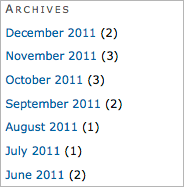What Is Your SEO Archiving Plan?
If the answer to this question is stunned silence, your website could lose long-term search engine visibility. Archiving has always been an important part of the SEO process.
 During consultations for search engine optimization services, the topic of blogs and other types of social media inevitably arises. I observe plenty of enthusiasm about blog content and fresh search results. I listen attentively to client ideas and concerns. Then I ask a simple question.
During consultations for search engine optimization services, the topic of blogs and other types of social media inevitably arises. I observe plenty of enthusiasm about blog content and fresh search results. I listen attentively to client ideas and concerns. Then I ask a simple question.
“What is your SEO archiving plan?”
Do you know what the typical response is? Stunned silence.
Then I ask another question:
“Who is in charge of archiving your blog content as well as your corporate website content?”
Do you know what the typical response to that question is? Continued silence. More stunned expressions. People looking at each other to see who might have the answer to that question.
You see, to too many people, SEO is all about keywords and rankings and freshness and the latest flavor-of-the-month tactic. A topic like archiving does not appear on an SEO professional’s radar until a specific situation arises, such as a site redesign or a migration to a new content management system (CMS).
The Costs Of Not Having An Archiving Plan
Long time Linking Strategist Eric Ward, who also publishes LinkMoses Private, shared this URL archiving horror story with me:
“I worked with a client for many years, each month seeking links for the new content they added each month. This new content was always subject specific, and was placed within a subdirectory at a nice short URL that made the link seeking process easier. In this company, the marketing departments and IT departments didn’t communicate every decision they made to each other.”
“Well, the IT department made the decision to change web content delivery platforms, but they did not share this with the marketing folks, who had no idea it was happening. Overnight thousands of URLs changed, with no redirects in place. Nothing but 404s.”
“This meant that all the deep links I had obtained over the course of several years became useless. There was no migration or archiving plan in place. There was no old site map or list of previous URLs. The lesson from this is Web sites demand planning and cooperation across departments. One decision can wreck a lot of work.”
Unfortunately, I encounter this type of situation all too frequently. There is a mad scramble to put together properly programmed 301 redirects without considering the searcher experience.
Web pages that should return 404 File Not Found errors are redirected to the home page in the chaos to retrieve lost link juice. 301 redirects might have to be implemented and re-implemented, diminishing their value. Web content that had solid link development and easy access is suddenly buried in the revised information architecture.
The costs of not having an effective archiving plan results in lost search engine visibility (temporary and long-term), diminished brand credibility, and considerable staff/outsourcing time and expense to repair the damage. Ultimately, these items lead to lost prospects and lost sales.
Archiving Blog Content

Many pre-formatted blog templates offer archives by date, but this feature is not enough for effective SEO and overall findability.
So let’s go back to my original situation. During the wave of enthusiasm for launching a blog for increased freshness, spidering, and (hopefully) increased search engine visibility, an archiving plan is never discussed.
And if archiving is mentioned? The answer is a typical brush off — just use the pre-programmed archives in the blog software. End of archiving discussion.
Well, I can tell you that pre-programmed blog archives is not an effective way to archive content because users/searchers generally do not discover or locate desired blog content by date.
They search for it by keywords using either a commercial Web search engine or a site search engine. They browse by categories and related content. Therefore, it is important for blog content to contain both parent-child and sibling-sibling links to related content.
Too many blogs remain uncategorized or rely on tagged pages as a poor substitute for an effective information architecture.
(Note: Tagged pages on blogs typically lead to duplicate content delivery. Duplicate content delivery to search engines can result in less pages being indexed, important pages not being available to rank, and a compromised searcher experience.)
Furthermore, blog content should not be written once and discarded. If you want your blog content to have long-term search engine visibility and grow stronger over time, archiving and categorizing are a necessary part of the SEO process.
“Posting valuable website content is not for a one time, getting attention driving endeavour. It’s also about long-term value,” said Ezra Silverton, Website Architect at the Canadian-based 9th Sphere. “One key attribute to long-term content value is making it easily accessible to visitors and crawlers long after its posted.”
Think about this: every blog post you write is going to eventually disappear from the home page and top-level category pages. When those links disappear:
- How are you making that content accessible to both searchers and search engines?
- What parent-child links are available on blog template pages?
- What sibling-sibling links are available on blog template pages?
- If you cannot put these links in the template, how else are you accommodating natural finding behaviors?
If you didn’t have an archiving plan from the outset, imagine the amount of work it would take to implement these items and achieve the long-term benefits. Not having an archiving plan or strategy ultimately hurts all types of websites…not only blogs.
As SEO professionals, we understand that SEO should never be an afterthought during the site design or redesign process. SEO works the best when it is addressed during the planning stages of website development. Archiving is no different. Archiving is an important part of the SEO planning process. It shouldn’t be an afterthought.
In other words, the answer to, “What is your SEO archiving plan?” should never be stunned silence.
Contributing authors are invited to create content for Search Engine Land and are chosen for their expertise and contribution to the search community. Our contributors work under the oversight of the editorial staff and contributions are checked for quality and relevance to our readers. The opinions they express are their own.
Related stories
New on Search Engine Land